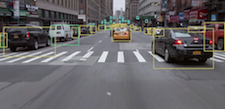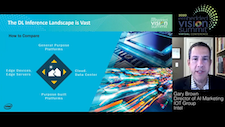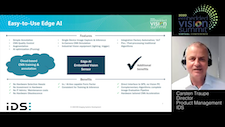| LETTER FROM THE EDITOR |
Dear Colleague,
On Tuesday, January 12, 2021 at 9 am PT, Imagination Technologies will deliver the free webinar “The Role of Neural Network Acceleration in Automotive” in partnership with the Edge AI and Vision Alliance. Industry research suggests that demand for ADAS will triple by around 2027. In addition, the automotive industry is already looking beyond this to full self-driving cars and robotaxis. Neural networks are fundamental to and will underpin this evolution from Level 2 and 3 ADAS, to full self-driving at Level 4 and Level 5. These systems will have to cope with hundreds of complex scenarios, absorbing data from numerous sensors, such as multiple cameras and LiDAR, for solutions such as automated valet parking, and intersection management and driving safely through complex urban environments. In this interview session, Jamie Broome, Head of Automotive Business, and Andrew Grant, Senior Director of Artificial Intelligence, both of Imagination Technologies, will share their thoughts and observations on the role of neural network acceleration in the future of automotive, as well as share insights on the company’s product line and roadmap. For more information and to register, please see the event page. And on Thursday, January 21, 2021 at 9 am PT, Horizon Robotics will deliver the free webinar “Advancing the AI Processing Architecture for the Software-Defined Car,” also in partnership with the Alliance. Edge AI applications for automotive, such as the intelligent cockpit, ADAS and autonomous driving, have set the bar for one of the biggest technology challenges of our time. While the race toward the ultimate driverless vehicle accelerates, AI applications find their way into today’s vehicles at an increasing rate, thus demanding computing performance with high accuracy, high reliability, energy efficiency and cost effectiveness. The Horizon Robotics Journey optimized processor series and Matrix computing system, paired with state-of-the-art AI and computer vision software and an efficient AI toolkit, have emerged as one of the most efficient AI-optimized solutions for smart mobility. This webinar will cover the company’s hardware architecture and roadmap, various vision application examples, selected partnership projects, and a proposal for metrics that best represent production price, power and performance for comparing AI processing platforms. For more information and to register, please see the event page. Brian Dipert |
| INFERENCE PROCESSOR BENCHMARKING |
|
Getting Efficient DNN Inference Performance: Is It Really About the TOPS? Benchmarking vs. Benchmarketing: Why Should You Care? |
| CAMERA DEVELOPMENT AND IMPLEMENTATION |
|
How to Create Your Own AI-Enabled Camera Solution in Days Smart Factory and Smart Life: AI Embedded Vision Camera |
| UPCOMING INDUSTRY EVENTS |
|
Yole Développement Webinar – Sensor Fusion for Autonomous Vehicles: December 15, 2020, 9:00 am PT BrainChip Webinar – Power-efficient Edge AI Applications through Neuromorphic Processing: December 17, 2020, 9:00 am PT Imagination Technologies Webinar – The Role of Neural Network Acceleration in Automotive: January 12, 2021, 9:00 am PT Horizon Robotics Webinar – Advancing the AI Processing Architecture for the Software-Defined Car: January 21, 2021, 9:00 am PT Vision Components Webinar – Adding Embedded Cameras to Your Next Industrial Product Design: February 16, 2021, 9:00 am PT |
| FEATURED NEWS |
|
Intel Announces Its First Structured ASIC for 5G, AI, the Cloud and the Edge Mythic Launches Its First AI Analog Matrix Processor Gyrfalcon Technology Unveils AI-X, a Full-Stack Solution for Edge-AI Development An Upcoming Webinar Explores Best Practices When Working with FRAMOS’ Industrial RealSense Camera GrAI Matter Labs Raises $14M to Bring High Performance AI per Watt to Every Device on the Edge |
| VISION PRODUCT OF THE YEAR WINNER SHOWCASE |
|
Morpho Semantic Filtering (Best AI Software or Algorithm) Please see here for more information on Morpho and its Semantic Filtering. The Vision Product of the Year Awards are open to Member companies of the Edge AI and Vision Alliance and celebrate the innovation of the industry’s leading companies that are developing and enabling the next generation of computer vision products. Winning a Vision Product of the Year award recognizes leadership in computer vision as evaluated by independent industry experts. |







